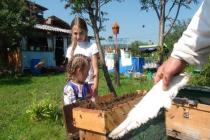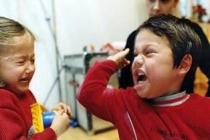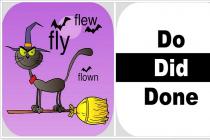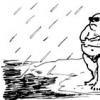Scientific research project
"Cartoons in children's lives»
Scientific adviser:
biology teacher
City of Nizhny Novgorod
Municipal educational institution secondary school No. 41
5 "A" class
Introduction……………………………………………………………………………….3-4
1. First, a little history………………………………………………………Comparison of domestic and foreign cartoons………………………. …7-10
3. Practical part……………………………………………………………….. …11- 15
4. Conclusion……………………………………………………………………………………….16
5. References…………………………………………………………………………………. ..17
Introduction.
Childhood is the most wonderful time in a person’s life. But what is most connected with him? Of course, cartoons! Generations grow up on them!
I once asked my mother if she liked to watch cartoons as a child. Her answer was in the affirmative. For them, children of the 70s, this was an extraordinary event. "Mother! Cartoon!” - the kids shouted. And the adults were forced to drop everything and, succumbing to persistent demands, watch an amazing fairy tale with their children. She carried them along the colorful, sparkling waves of funny and sad, instructive and enigmatic, mysterious and funny stories...
Now we, their children, watch cartoons. These are cartoons of Soviet and foreign production. But for some reason, more and more parents have doubts about the safety and benefits of foreign animated products for us. Where do they get this oppressive feeling of anxiety, where does the suspicion that something wrong and irreparable is happening? In my work, I tried to understand how cartoons influence the children's psyche.
Goal of the work: Based on work with literature and practical research, identify the impact of modern cartoons of domestic and foreign production on the consciousness of children, and find out which cartoons will benefit the child.
Job objectives:
1) find out in specialized literature how the animation genre appeared;
2) find out what dangers the fictional world of animation hides;
3) conduct a survey of students in grades 1-5 in order to identify the most preferred cartoons and their characters;
4) study how Western cartoons influence the anxiety and aggressiveness of younger schoolchildren;
5) analyze the research results and draw conclusions;
6) make a memo “How to watch cartoons profitably”
Subject of study– cartoons of domestic and foreign production.
Work hypothesis: cartoons of Russian and foreign production, in which there is more kindness, rather than violence, will contribute to the harmonious development of the child, and those in which there is a lot of violence will develop in the child anxiety, fears, and uncertainty in communicating with adults and children.
1. Literature study
2. Watching cartoons
3. Conducting a survey of students in grades 3-5 and their parents
4. Analysis of the results obtained
The topic is relevant because today there is a wide variety of cartoons. We all constantly watch foreign and domestic cartoons. Many guys prefer watching TV to games.

1.Theoretical part
 First, a little history.
First, a little history.
 Animation is older than natural cinema. Time must be counted from the moment of the invention of a device capable of “animating” drawings. On July 20, 1877, the talented inventor and self-taught engineer Emile Reynaud made a report in France at the Academy about his work and demonstrated the praxinoscope apparatus he had designed - something like a mechanical toy with a tape covered with pictures and a rotating mirror drum. Subsequently, Emil Reynaud improved his apparatus. Today there are other techniques: Puppet animation, Silhouette and collage animation, computer animation. The first animation studios were created by Barr and Bray in 1915. Cartoon characters were borrowed from newspaper comics or invented by studios. The most popular silent cartoon character was Felix the cat, created in 1917 by P. Sullivan, and improved in the 1920s by O. Mesmer. Early animation was silent. To convey dialogue, either “balloons” were used, as in comics, or titles, as in films. A young animator from Los Angeles, W. Disney, directed the first cartoon with synchronized sound, “Steamboat Willie” (1928). This was also the first Mickey Mouse cartoon.
Animation is older than natural cinema. Time must be counted from the moment of the invention of a device capable of “animating” drawings. On July 20, 1877, the talented inventor and self-taught engineer Emile Reynaud made a report in France at the Academy about his work and demonstrated the praxinoscope apparatus he had designed - something like a mechanical toy with a tape covered with pictures and a rotating mirror drum. Subsequently, Emil Reynaud improved his apparatus. Today there are other techniques: Puppet animation, Silhouette and collage animation, computer animation. The first animation studios were created by Barr and Bray in 1915. Cartoon characters were borrowed from newspaper comics or invented by studios. The most popular silent cartoon character was Felix the cat, created in 1917 by P. Sullivan, and improved in the 1920s by O. Mesmer. Early animation was silent. To convey dialogue, either “balloons” were used, as in comics, or titles, as in films. A young animator from Los Angeles, W. Disney, directed the first cartoon with synchronized sound, “Steamboat Willie” (1928). This was also the first Mickey Mouse cartoon.
 V, the founder of three-dimensional animation, begins work at Khanzhonkov’s company on the first three-dimensional animated film “The Development of a Tadpole,” performing time-lapse photography of live tadpoles in water. 1911 can be considered the year of birth of Russian animation.
V, the founder of three-dimensional animation, begins work at Khanzhonkov’s company on the first three-dimensional animated film “The Development of a Tadpole,” performing time-lapse photography of live tadpoles in water. 1911 can be considered the year of birth of Russian animation.
 Animation is a derivative of the Latin "anima" - soul, therefore, animation means animation or animation. In our cinema, animation is often called animation (literally, “reproduction”).
Animation is a derivative of the Latin "anima" - soul, therefore, animation means animation or animation. In our cinema, animation is often called animation (literally, “reproduction”).
Creating animation is a long, labor-intensive process. The producer defines the overall concept, the writers develop the plot and script, which is then broken down into episodes and scenes, illustrated by a series of sketches. But despite the fact that today all cartoons are created in many countries around the world, not all of them, it turns out, are recommended to be watched... What do we see on our TV screens? Why do some cartoons cause a storm of joyful emotions, a wave of imitation of favorite characters and form good emotions in a child, while others cause outright harm, making children angry? Among cartoon creators, there are two opinions: those who copy adult life in cartoons, and those who create a children's world with its own laws of life. Modern children are increasingly inclined to imitate adult life with its aggression and cruelty, which is why they prefer the first type of cartoons
We asked in the Gorbushka video salon in Neryungri which cartoons adults buy most often for their children. We were told that most of the purchases were foreign novelties. For many children, watching Russian cartoons is not as interesting as the action-packed and colorful foreign ones. All children choose cartoons based on the principle of colorfulness and interest, fashion in the classroom or kindergarten. But many Russian cartoons were created based on fairy tales. Soviet cartoons by their nature are interesting in their plot and make you think. What is the situation with foreign cartoons? Almost half of foreign cartoons are built according to the old, proven principle: beginning - climax - denouement. Crime - investigation - punishment. Therefore, the main themes of American films are conflicts and crimes.
Most modern cartoons have the following features:
1.Bright, the action happens very quickly
2. A simple, understandable plot that is repeated in all cartoons.
3. The importance of speech for understanding the cartoon is reduced to a minimum.
5. Lots of aggression.
6. Monotonous music.
2. Comparison of domestic and foreign cartoons.
Now try to conduct a little experiment on yourself. Watch, for example, an episode from the series “Woody and His Friends”, which lasts 10 minutes and retell it. What will happen? Well, probably 1-2 sentences before someone hit someone, hit someone, and Woody said his famous: “Ta-ta-ta-ta-ta.” Now watch a cartoon, for example, “OH and AH,” which also lasts 10-15 minutes. Answer the question: What does the story tell us? The baby, like a sponge, absorbs what he sees on TV. He still does not know how to distinguish fiction from reality. For him, all the heroes are absolutely alive and real. And it is them that he will copy in his behavior, intonations, and games. Abroad, cassettes with the cartoon “Tom and Jerry” are often labeled: “For children over 6 years old.” Still would! The kid takes it for granted and natural that you can skin a cat, and at the same time he will not only be alive, but also cheerful. Or a mouse  you can hit her on the head, blow her up, poison her, but she will remain invulnerable, continuing to plot the misfortune of the unfortunate Tom.
you can hit her on the head, blow her up, poison her, but she will remain invulnerable, continuing to plot the misfortune of the unfortunate Tom.
Now, let’s compare in more detail the characters and what cartoons of domestic and foreign production teach.
Let's take and look at several domestic and foreign cartoons as examples.
"The Littlest Dwarf" A cartoon about how the smallest gnome named Vasya learns to do good, in each of several episodes rescuing the heroes of fairy tales from trouble: Little Red Riding Hood, seven kids, three piglets... There is a wonderful image of one “rescuer” in this cartoon
"Magic bag"
The plot is recognizable: the well-bred bear Spiridon has a grandson, Ivashka, who, more than anything in the world, loves to play mischief and do what he wants. The animals complain, the grandfather worries, and finally decides on a pedagogical experiment: “If you want to be naughty, play naughty! You won’t hear a word from me. But first, fill this bag with pebbles.” Hooray! Yes  Hello pranks!
Hello pranks!
But it turns out that you can put a pebble in a bag only if you do a good deed. There is a well-known spiritual law: when there is no love and mercy in you, do deeds of mercy and gradually educate your heart.
"Best Friend" From his native latitudes, he takes us to mysterious Africa, where an evil crocodile and an African girl live with friends - a puppy, a chicken, a bell and a hippopotamus. Naturally, the hippopotamus claims the title of greatest friend. The cartoon (which, of course, ends well) is very intelligible even for the little ones. At the end, the girl “on her fingers” explains to the hippopotamus: “Look how small they are, and they are all my great friends. Well, the hippopotamus has nothing left to do but cry in three streams. But we all understood who is the biggest friend here and how In general, you need to be friends. Well, okay, this is all clear: you need to help friends.
Watch your little one watching a good cartoon. There is a whole flurry of emotions and experiences on his face. Here he laughs with the hero, here he frowns, empathizing and regretting, here he repeats the words of a familiar song... Good cartoons have great educational value. They will teach the child to be friends and sympathize, to help comrades and protect the weak, to be generous and magnanimous, to love parents and grandparents, they will show the way out of many difficult situations, and they will relieve childhood fears. In them, the little viewer will find another confirmation that evil will be punished, and good will always triumph.
 Consider a typical American cartoon " Goofy and his friends."
Consider a typical American cartoon " Goofy and his friends."
Already from several randomly watched episodes of this endless cartoon, one can isolate one frequently repeated plot: there is a certain person who is busy with some very important matter for him. As a rule, he is busy with something quite useful, if not socially (an employee of some company serving the population), then for himself personally (building something for himself, growing something, etc.). And there is an idle slacker, very busy entertaining himself. Considering the above plot plot, the conflict unfolds between the hero - Goofy and objects. Since Goofy is a hero, naturally he must win.
 As a result of the action, it turns out that the hard worker who somehow interfered with the woodpecker in his business of entertainment suffers a crushing defeat, and Goofy appears as a kind of gallant hero, terribly
As a result of the action, it turns out that the hard worker who somehow interfered with the woodpecker in his business of entertainment suffers a crushing defeat, and Goofy appears as a kind of gallant hero, terribly
inventive, and exposing all his “enemies” as incompetents, fools, and, in general, losers.
Let's take another cartoon as an example. "Ninja Turtles". Shredder in Teenage Mutant Ninja Turtles, all these cyborgs are the modern embodiment of evil. This is not typical for a Russian child; in this cartoon there is a constant confrontation with the bad, and the heroes kill so much that sometimes you wonder if they are really that good?
 In American stories, very often the image of a girl is also very cruel. The traditional female qualities are ridiculed: shyness, selflessness, modesty and, most importantly, motherhood. You, of course, have seen the episode from “Shrek” (when the bird explodes from the troll’s singing). Children always laugh at this moment. This is how a shift in consciousness is achieved. Thus, the psyche of our children is changed by strangers. This is not just a beautiful murder scene, it is an example of death. The main positive heroine of our fairy tales cannot be like that, she cannot be cruel, she cannot kill. All cartoons invariably contain monsters and mutating people. They are shot at, blown up, killed, and fly in cars, planes, and spaceships that are incomprehensible to my brain. It would be a stretch to call these fairy tales good.
In American stories, very often the image of a girl is also very cruel. The traditional female qualities are ridiculed: shyness, selflessness, modesty and, most importantly, motherhood. You, of course, have seen the episode from “Shrek” (when the bird explodes from the troll’s singing). Children always laugh at this moment. This is how a shift in consciousness is achieved. Thus, the psyche of our children is changed by strangers. This is not just a beautiful murder scene, it is an example of death. The main positive heroine of our fairy tales cannot be like that, she cannot be cruel, she cannot kill. All cartoons invariably contain monsters and mutating people. They are shot at, blown up, killed, and fly in cars, planes, and spaceships that are incomprehensible to my brain. It would be a stretch to call these fairy tales good.
What does this lead to:
1.The brightness of the cartoon makes it easy to attract the child's attention. As a result, the child does not have to make any effort to learn to concentrate. An inability to concentrate develops, and at school the child cannot sit through a lesson and remember all the material.
2. A clear, simple plot does not always allow imagination and fantasy to turn on. But cartoons are another way to develop thinking, attention and memory.
3. During the school period, the child’s speech develops most intensively. Therefore, it is important to hear correct, beautiful native speech, to hear all the intonations and feelings conveyed by speech. Lack of correct speech can lead to delays in its development.
4.Through cartoons, the child learns behavior patterns, methods of action, and learns how to achieve his goal. Unfortunately, this method is often aggression. According to numerous studies, children who watch mainly foreign cartoons experience an increase in cruelty and aggressiveness.
3.Practical part

Research results.
1. In grades 3-5 of our school, I conducted a survey of students.
Questionnaire for students
Class ___________
1.Do you watch cartoons? ( Not really)
2.When do you prefer to watch cartoons? (morning, afternoon, evening)
5.Favorite cartoon characters

We conducted a study - a survey in the form of a questionnaire. The study showed that all children love cartoons. Most parents do not want to limit their children's choice of cartoons. The right to choose a cartoon belongs to the child. This is a very worrying sign. Most often, children choose foreign cartoons, giving preference to such cartoons as “Sorceresses”, “School for Sorceresses”, “Lilo and Stitch”, “The Simpsons”, “Futurama”. They watch cartoons more than 4 hours a week, which is harmful to their eyesight and overall health. Children's favorite heroes are those who can commit cruel acts and even murder. Can you imagine if in life a child begins to copy the behavior of his favorite heroes?! The children in the questionnaire even find it difficult to name 10 “our” cartoons, but this is our history and culture. I think parents need to think about this and monitor what their children watch.
Cartoons should:
1) Teach to love animals. Cartoon characters are often animals.
2) Learn to be friends.
3) Help to study the world around us
4) Teaches you how to perform your duties. Therefore, heroes must show by example how to perform certain actions.
5) Stop watching animated series. The cartoon must have a plot, preferably based on the interaction of the team.
6) Watch cartoons no more than 2 hours a week.
7) Retell the contents of the cartoon to mom and dad.
Conclusion
Children like to watch cartoons, but not everything they like is good for us. When a child likes a knife and begins to play carelessly with it, the parents take it away, but when you watch a “bad” cartoon, moral qualities are developed; you can clearly see the disrespect, cynicism, and sometimes cruelty of the heroes of some cartoons towards their family and parents , brothers, sisters. In many cartoons, they are endowed with the main, positive character. And unnoticed, these vices eat into the child’s consciousness, because positive heroes need to be imitated.
So, let's summarize. In one of the cities several years ago, psychologists studied the influence of various cartoons on the children's psyche. It turned out that after watching “Soviet cartoons,” children calmed down, became more friendly, and their sleep and appetite improved. After American computer cartoons, children's fears and aggressiveness increased, they began to be capricious, fight, and break toys. Meanwhile, in recent years you have very rarely seen Cheburashka or Winnie the Pooh on the screen, but aggressive animated series have filled all channels. Of course, it is impossible to clearly divide cartoons into bad and good, but since we have a completely different culture, it is better for Russian children to watch Russian cartoons.
During the study, my hypothesis was confirmed; we proved that not all cartoons have a positive effect on children. Therefore, I recommend watching more domestic cartoons.
Bibliography
1. “Cartoon Planet”, article “My Baby”, Moscow, 2003
2. “About our Unionmultfilm”, G. Borodin, 2005
3. Articles on the Internet
4. Articles by psychologists: 1. Tatyana Genina.
2.Eduard Uspensky.
5.TV show “Moscow Week”
Municipal Budgetary Educational Institution
"Secondary school No. 2 of Rudnya"
Research project on the topic:
“How cartoons influence a child’s psyche”
Work completed
4th grade student Sofia Zhiganova
Head: Tereshchenkova S.I.
2016 – 2017 academic year

Content
Introduction………………………………………………………………………………………34
Chapter 1. Domestic cartoons……………………………………………………...…..5
1.1. Cartoon “Magic Bag” (directed by A. Polushkin,
“Kuibyshev telefilm”, 1975)…………………………………………...….. 6
1.2. Cartoon “The Littlest Dwarf” (directed by M. Kamenetsky,
"Soyuzmultfilm")………………………………………………………...…7
Chapter 2. Foreign cartoons………………………………………….…8
2.1. Cartoons Made in America…………………………………910
Chapter 3. Practical part……………………………………………………………..11
3.1.Survey of classmates…………………………………………………...…
11
Conclusion…………………………………………………………………………………12
Literature………………………………………………………………………………13
Appendix ………………………………………………………………………………14

2
Introduction
There is probably not a child in the world who doesn’t love cartoons. I
I also really like watching cartoons. But my parents don't allow it
me and my younger sister watch all the cartoons in a row. They
claim that there are cartoons that negatively affect our
development and psyche. I decided to study this topic and find out whether it is fair
Is this an opinion?
Purpose of the work: to find out how cartoons affect development and psyche
children.
Tasks:
1. study how cartoons influence primary schoolchildren;
2. compare domestic and foreign cartoons
3. find out what dangers the fictional world hides
animations;
4. conduct a survey of students
4b class, with the purpose
identifying the most preferred cartoons and their characters
5. analyze the research results, draw conclusions;
6. create a memo “How to watch cartoons profitably”
Hypothesis of work: cartoons of Russian and foreign production, in
which more kindness, and not violence, will contribute to harmonious

development of the child, and those in which there is a lot of violence develop in the child
anxiety, fears, uncertainty in communicating with adults and children.
Object of study:. cartoons
production.
Subject of research: domestic and foreign cartoons
3
Research methods:
1. Literature study
2. Watching cartoons
3. Conducting a survey of 4th grade students
4. Analysis of the results obtained
5. Drawing up recommendations.

4
Many parents sooner or later think about what
cartoons influence their children. When choosing a cartoon you need
be more careful than in choosing a book, because visual images
have a much stronger impact on the child. If we talk about “Soviet”
cartoons, they are good because they reflect the normal
child's picture of the world, evil in cartoons is not eternal, but good is eternal. Very
it is important that in “Soviet” cartoons the evil character was presented as
humorous form, which balanced his negative essence.
Chapter 1. Domestic cartoons
Some of the best domestic cartoons are small
parables in which a deep, entertaining story is hidden
spiritual meaning. Moreover, many cartoons are not easy to show
“positive” dolls and animals, but also provide a program for educating oneself
qualities of a real person.

5
1.1.
Cartoon “Magic Bag” (dir. A. Polushkin,
"Kuibyshev television film", 1975)
The plot is recognizable: the well-bred bear Spiridon is growing a grandson
Ivashka, who more than anything in the world loves to play mischief and do what
I want to. The animals complain, the grandfather worries and finally decides to
pedagogical experiment: allows the grandson to be mischievous, but at the same time
fill the bag with pebbles after each good deed done.
At first he has great difficulty finding some useful application
of his bearish strength, then he sees more and more around
opportunities to help someone and the bag, after a while it became
full. The long-awaited freedom has arrived, but on other days too
various urgent matters were found, so there was no more time for mischief
is coming.
But if the heart is not educated, you have to start somewhere. It happens that
“counting your pebbles” becomes a habit and character trait,
which is called vanity.

1.2.
“The Littlest Dwarf” (dir. M.
Cartoon
Kamenetsky, Soyuzmultfilm).
Explain this to the child if he is really trying to do something.
good, but solely out of hope for praise, you can use
cartoon
"The Littlest Dwarf"
(dir.
M.
Kamenetsky,
"Soyuzmultfilm"). It is also about educating the heart, about how to
a little gnome named Vasya learns to do good in each of several
series rescuing fairy tale heroes from trouble: Little Red Riding Hood, seven kids,
three little pigs and others. There is a wonderful image in this cartoon
"rescuer". This cartoon is good not only because of what it has
positive Vasya, who defeats the wolf, and the fact that Vasya at the same time
the smallest. This means that if someone needs help, growth does not matter
meanings.

7
Chapter 2. Foreign cartoons
Nowadays foreign cartoons are especially popular,
mostly American. Most of the American factory's products are not
harmless, there is a big difference between domestic old ones
cartoons and foreign ones. Behind this difference there are profound
discrepancies in the picture of the world

8
2.1.Cartoons made in America
An American cartoon, but at first glance it seems very harmless.
First of all, these cartoons have a completely different picture of the world. World,
The background against which the events of the cartoon take place lies hopelessly in evil.
And only grains of goodness in the form of some ninja turtles try to
fight evil. And evil, as a rule, is destroyed physically, which is absolutely
not usual for our way of acting in fairy tales, where we tried with evil
fight in other ways: they tried to outwit him or persuade him.
Some parents simply forbid their children to watch them. They
perceive these cartoons as “very evil and not teaching good.” A
many do not forbid their children to watch them. It is not because they are not prohibited
that they did not feel the corrupting influence of these products, but because
They didn't even look at them. The reason they don't watch these films is because
got used to the Soviet system “on TV, children don’t see anything bad”

"They'll show you." Television is aimed at children, both young and
growing up. There are many channels to attract children,
which show cartoons and TV series. When a child looks
cartoons, as if disconnected from everything that surrounds him. Not
reacts to normal speech sounds, and after watching cartoons or
TV series, non-childish aggression awakens in a small child, and sometimes
fears.
Such wonderful animated films from Walt Disney Studios as
"Snow White", "Bambi", "Beauty and the Beast", "The Lion King", carried in
a good start for yourself. But these films are rarely shown on TV.
And children most often watch low-quality products about mechanical
monsters, vampires, ghosts and almighty robots. In almost all of these
cartoons contain conflict, fight, battle,
shootout, murder, that is, elements of aggressive behavior and violence.
And almost all the children are literally captured by animation,
and they often refuse to play - just to sit in front of the TV.
The child perceives almost all information in the form of images, from which
then his model of the world is built. Children like to watch cartoons, but
not everything they like is good for them. Cartoons
have a great influence on the development and psyche of children. On the one hand,
these are bright, spectacular, imaginative, simple, unobtrusive, accessible to children
cartoons. Which form their primary ideas about good and
evil, standards of good and bad behavior. By comparing yourself with
favorite characters the child has the opportunity to learn positively
perceive yourself, cope with your fears and difficulties,
treat others with respect. The events taking place in the cartoon
allow children to be raised: to increase their awareness, develop
thinking and imagination, shaping his worldview.

Thus, cartoons are an effective educational tool.
child.
10
Chapter 3. Practical part
3.1.Survey of classmates
As a result of the theoretical research, I decided
research which cartoons my classmates prefer. For
So I conducted a survey among students in my class.
The survey result showed that all students 100% like to watch
cartoons. Moreover, 21% love absolutely all cartoons, be it
foreign or Russian. 46% prefer foreign cartoons,

because they are colorful and more modern. And 33% are Russian cartoons,
because they are cheerful and kind.
However, the guys found it difficult to name 10 Soviet or Russian
cartoons. Here are the results. 38% named from 1 to 4 cartoons,
from 5 to 8 – 42%, from 9 to 12 – 20%
Conclusion
11
Children like to watch cartoons, but not everything they like is for us
healthy. When a child likes a knife and starts being careless with it
play - his parents take him away, but when you watch “bad”
cartoon, and parents do not prevent viewing, then they can
qualities such as disrespect, cruelty, and anger are formed.
Good cartoons will teach you to be friends and sympathize, to help your comrades and
protect the weak, be generous and magnanimous, love parents and

grandparents, they will show the way out of many difficult situations, they will save
from childhood fears. In them the little viewer will find another confirmation
that evil will be punished and good will always triumph
Meanwhile, in recent years you have very rarely seen Cheburashka on the screen,
Carlson, but aggressive animated series filled all channels. Certainly,
one cannot say that there are no good foreign cartoons. They are.
And therefore we need to learn to choose from the flow that we
the best is offered.
During the study, our hypothesis was confirmed; we proved that not all
Cartoons have a positive effect on children. That's why we
We recommend watching more domestic cartoons.
Literature
12
1. Abramenkova V., Bogatyreva A. “Children and the television screen.” //
Education of schoolchildren 2006, p.28 31
2. Aromashtam M. “Children watch cartoons: psychological and pedagogical
notes". // Chistye Prudy, 2006, p.32
3. Large encyclopedic dictionary. M.: scientific. publication "Big
Russian Encyclopedia", 1998, p. 1434

4. Glushkova E. “Television and children’s health.” // Education of schoolchildren
1989, p. 8891
5. Gundareva I. “On the consequences of the perception of television information.” //
Education of schoolchildren, 2005, p. 4554
Internet resources:
6. http
:// www
. blogpediatra
Ru //
7. http
:// www
. fun
4 children
. ru /
8. http
:// www
. volgograd
Ru /
9. http
://meduniver
. com
/
10. http://www.psychologiaguide.ru/
13

3) Help to study the world around us
4) Teaches you how to perform your duties. Therefore, heroes must lead by example
show how to perform certain actions.
5) Stop watching animated series. At the cartoon
there must be a plot that is kind, funny, instructive, challenging
positive emotions and feelings.
6) Watch cartoons no more than 2 hours a week.
7) Retell the contents of the cartoon to mom and dad.
8) Read works based on cartoons (for example,
read V. Nosov’s “Dunno and His Friends,” watched the cartoon,
based on the story)
14
Municipal educational institution
"Verkh-Katunskaya secondary school"
Biysk district of Altai region
Social project
Topic: “How cartoons influence a child”
Performed: Gladysheva Alina
student of 1st "A" class
Supervisor: Doronina Zhanna Valerievna
primary school teacher
MBOU "Verkh-Katunskaya secondary school" Biysk district
Verkh-Katunsk 2016
Project plan
Introduction:
Relevance;
Target;
Tasks;
Hypothesis.
Main part.
a) The role of cartoons in the formation of personality:
Knowledge of the surrounding world;
Conveying the image of friend and enemy, the idea of good and evil, bad and good deeds;
Help in dealing with fears and difficulties;
Development of imagination;
The influence of color images of faces and cartoon characters.
b) Signs of “harmful” cartoons:
Aggressive behavior of heroes;
Violation of generally accepted rules of behavior;
Displaying dangerous behaviors;
Disrespectful attitude towards others.
Conclusion.
a) conclusions based on the results of the study;
Bibliography.
Project topic: “How cartoons influence a child.”
Objective of the project: understand the benefits and harms of cartoons.
Relevance of the topic: I consider this topic very relevant, since the cartoons watched have an impact on the formation of the child’s personality. It is important for me to think about whether cartoons are more harmful or beneficial.
Tasks:
Watching cartoons with classmates;
Discussion of plots and actions of cartoon characters;
To understand whether cartoons are really as harmful as adults say about them and if so, why?
Project hypothesis: Are cartoons really as harmful as psychologists write about them and adults say?
Everyone loves watching cartoons! But I tried to figure out what was so attractive about them.
What is a CARTOON - a means of education or mental control?
Cartoons can distract a child in various situations - this is a great help for parents.
The characters speak the same language as the children.
Cartoons have educational and developmental functions in a child’s development.
Bright and spectacular on the one hand, and simple, accessible on the other, cartoons have great educational potential, and are very close to a fairy tale or communicating with people.
Cartoon characters show us different ways of understanding the world around us, convey images of friend and enemy, give us the first ideas about good and evil, bad and good behavior.
By comparing ourselves with our favorite character, we learn to cope with difficulties, with our fears, and learn to treat others with respect.
The events shown in the cartoon develop our thinking and imagination.
This means that cartoons are a very effective means of education.
BUT! I would like to object! Nowadays they show a lot of cartoons that not only teach nothing, but are also very dangerous for our psychological health.
Moreover, as it turned out, the most dangerous influence on us is exerted by foreign cartoons, which we all love so much.
Let me give you a few examples of the impact on our psyche with the help of cartoons:
Cartoons are close to real life - money, crime, ecology, struggle for power.
They demonstrate aggression, fights and wars - leads to aggressive behavior.
Cartoon characters are ugly and even ugly.
Character color and color scheme
The colors of the heroes themselves are bright, and even poisonous, and any of their actions is accompanied by a quick change, flickering of bright colors. This technique of cartoon creators rivets the child’s attention to the character, who leads him where he wants, without giving him the opportunity to be distracted or think.
L Itza of the main characters
They all look alike! It turns out that a certain standard of beauty is being imposed on us! And all girls strive to be like these identical cartoon dolls!
In fact, there are a lot of examples that can be given, but here are the main ones:signs of “harmful” cartoons highlighted by child psychologists:
Cartoon characters are aggressive, they seek to harm others, and often maim or kill other characters. The consequence of watching such a cartoon can be a manifestation of cruelty, ruthlessness, and aggression by a child in real life.
No one punishes a cartoon character who violates generally accepted rules of behavior, no one puts him in a corner, no one says that he can’t do that. So, it turns out that this behavior is normal? The idea of good and bad deeds is disrupted.
The cartoon shows life-threatening forms of behavior that are stupid and sometimes downright dangerous to repeat in real life! Looking at such role models can even lead to injury.
They show scenes of disrespect towards people, animals, plants, scenes of mockery of helplessness, weakness, and old age. How do you think little viewers will behave after watching such cartoons? Most likely, it will be obscene behavior, rudeness, ruthlessness...
Me with my classmates I watched and discussed many cartoons and completely agree with the opinions of psychologists and parents and consider it necessary to adhere to the following rules:
Communication with a blue screen should not exceed 1.5 hours a day. The danger of prolonged viewing is a possible state of excitement and irritability, or, conversely, inhibited reactions.
You should not watch TV in a completely darkened room, as too sudden changes in brightness quickly cause visual fatigue.If possible, watch cartoons during the day or evening in a well-lit room.It is important to sit directly in front of the screen, at a distance of at least 2.5-3 meters, on a sofa or chair with a vertical back that serves as support for the spine.
We don’t need to watch everything, we need to listen to the opinions of adults who help us choose good programs or cartoons to watch.
The best thing is to go out and play with friends.
And the most important thing!
Dear parents! No cartoon can replace live communication with you, put aside your business and pay more attention to us!
Bibliography
Shishova T. L. The harm of American cartoons.
To create this project, materials from the following sites were used:
; ;
Municipal budgetary educational institution
"Secondary school No. 50"
"The influence of cartoons on children"
Prepared by:
Daria Kopyshenkova, 4th grade student
Scientific adviser:
Kholina E.M., primary school teacher
Kaluga
Introduction p. 2 – 3
Theoretical part p. 4 – 10
2.1. History of the creation of animated films p. 4
2.2. The benefits and harms of cartoons p. 5 – 8
2.3. Comparison of domestic and foreign cartoons p. 8 – 10
Practical part. With. 10
Conclusion. Conclusions. With. 10 – 11
Literary and electronic sources p. 12
Appendix p. 13 – 16
Introduction.
Each of us, regardless of whether we are an adult or a small child, a boy or a girl, is very individual. Therefore, some of us can spend hours looking at pictures in an old grandmother's book, while others would prefer to go for a walk on a bicycle or on roller skates. Boys play with cars, soldiers and robots, and girls put their favorite doll in a stroller with maternal care. But there is something that, without exception, both adults and children, boys and girls love. These are cartoons.
This love for cartoons is not accidental. Adults love cartoons because, on the one hand, they allow parents to distract the child for a while, and for the parents to mind their own business, and, on the other hand, they have important educational, cognitive and developmental functions. In addition, all adults were once children, and their favorite characters and funny stories remained in their memory.
For children, a cartoon is an amazing fairy tale: bright, magical, unforgettable. A fairy tale that teaches friendship, communication and mutual respect; explains what is good and what is bad, and that good always triumphs over evil.
More than a hundred years have passed since the appearance of the first cartoon. Much has changed since then. Our parents grew up on good domestic cartoons, the characters of which they know and remember: Winnie the Pooh and his friends, Baby and Carlson, Leopold the Cat, Pinocchio, Thumbelina, Cheburashka, Funtik, brownie Kuzya, Uncle Fedor from Prostokvashino and of course the legendary Hare and Wolf from "Well, wait a minute."
Today, a huge world of cartoons is opening up to young viewers. You can watch them endlessly, choosing genres, plots, characters. But not all cartoons, as adults claim, have a positive impact on the child’s psyche and upbringing. There are many opinions about the dangers and benefits of modern cartoons and about how long and what kind of cartoons can be shown to children for the full development of personality.
I recently had a younger brother, and I would like to figure out which cartoons will be educational and useful for him. That is why I chose this topic for research.
Goal of the work: Based on work with literature (opinions of parents, specialists, psychologists) and practical research, to identify the impact of modern cartoons of domestic and foreign production on the consciousness of children, and to find out which cartoons will benefit the child.
Job objectives:
study the history of animation;
find out what benefits and harm the fictional world of animation can bring;
conduct a survey in your class to identify the most preferred cartoons and their characters;
compare domestic and foreign cartoons;
analyze research results and draw conclusions.
Job Analysis will allow me to answer the following questions:
At what age can you show cartoons to a small child?
How long can a child spend watching cartoons?
What cartoons are useful for children, domestic or foreign?
Theoretical part
2. 1. History of the creation of animated films.
There are several versions of the appearance of the first cartoon.
According to one version, the French, as the founders of this art form, consider the birthday of animation to be August 30, 1877. It was on this day that the invention of the praxinoscope was patented by the French artist and self-taught inventor Emile Reynaud. A little earlier, on July 20, 1877, Emile Reynaud presented a report to members of the French Academy and demonstrated a praxinoscope - a device assembled from a cookie box and a mirror drum, and allowing one to view phase images on a transparent tape, creating the illusion of the movement of figures. The first cartoon was created in 1892, when the first show of “light pantomimes” took place at the optical theater of Emile Reynaud. Reynaud drew, painted and edited all his “films” himself, putting images on long tapes; each plot consisted of several hundred pictures.
According to another version, in 1906, the choreographer of the Mariinsky Theater Alexander Shiryaev created the world's first puppet cartoon, which depicts 12 dancing figures against a background of stationary scenery. The film was shot on 17.5mm film. It took three months to create it. During creation, Shiryaev rubbed a hole in the parquet floor with his feet, as he constantly walked from the film camera to the set and back.
There are earlier versions of creating animated films, but they cannot be called full-fledged cartoons. They were just a demonstration of the camera's capabilities.
The first cartoons were hand-drawn and hand-painted pantomimes lasting up to 15 minutes. Even then, sound synchronized with the image could be used.
Later, with the advent of computers, computer animation also appeared. Currently, these technologies have come so far that it is sometimes difficult for a non-specialist to determine what he sees on the screen - a “live” movie or an animated one.
If we talk about our country, it should be noted that in 1936 the Soyuzmultfilm film studio was founded in the USSR, which gave a huge leap to domestic animation.
In 1958, the first animated films in Japan created the "Anime" genre.
2. The benefits and harms of cartoons.
With the development of multi-industry, as we said earlier, a huge variety of animated films with various genres and plots are opening up for young viewers. Everyone has long known the fact that cartoons have a huge impact on the child’s nervous system. Parents, teachers, psychologists ask questions: aren’t modern cartoons dangerous for the developing psyche of a child? What to choose for your child: foreign or domestic cartoons? Should children be allowed to watch animated films? Are they healthy? And how much time can a child be allowed to spend in front of the TV? We will try to answer these questions, taking into account the opinions of experts.
First we should consider positive influence cartoons for a child.
It is no coincidence that animated films are loved by children of all ages. Bright, spectacular, imaginative on the one hand, and simple, unobtrusive, accessible on the other, cartoons are close in their developmental and educational capabilities to fairy tales, games, and live human communication. Cartoon characters show children a variety of ways to interact with the world around them. By comparing himself with his favorite characters, the child has the opportunity to perceive himself positively, cope with his fears and difficulties, and treat others with respect. The events taking place in the cartoon help raise the child’s awareness, develop his thinking and imagination, and shape his worldview. Thus, a cartoon is an effective means of raising a child, the main thing is to find a middle ground. Watching the “correct” cartoons has a number of positive aspects:
the child has opportunity to relax and unwind , get psychological relief;
child learns to perceive the plot and think logically ;
cognitive and educational impact (explain natural phenomena, develop speech, broaden horizons, etc.);
changing the picture on the screen with sound stimulates visual and auditory attention, promoting their development;
Watching cartoons together with your parents helps you find new interesting topics for discussion, which develops child's speech .
Now let's look at Negative influence cartoons on the child's consciousness.
There are a number of shortcomings that can lead to improper formation and development of the child’s psyche. Based on the opinions of D.V. Andryushchenko, N.E. Markova, I.Ya. Medvedeva, we can identify several signs of a “harmful cartoon” that a child should be protected from watching.
▪ Aggression and violence on screen. Too detailed scenes of fights with blood, murder (if the main character is aggressive, he can harm others, and the child can then imitate cartoon cruelty in his life). For example, research by A. Bandura, conducted by him and his colleagues back in the 60s of the twentieth century, proved that scenes of television violence seen by children increase their aggressiveness and form not the best character traits.
▪ Complete impunity(if the character’s bad deed is not punished, but even welcomed, the child may develop a feeling of permissiveness, which will lead to negative consequences in the future).
▪ There is no clear boundary between good and evil(even a positive character can do bad things for good purposes).
▪ Contempt towards a woman, mother, elderly people, animals and plants can cause aggression and rudeness in children. The “educational” moment of systematically watching such cartoons will not keep you waiting. Those closest to him will be the first to feel it in the form of cynical statements, indecent gestures, indecent behavior, rudeness and ruthlessness of the little TV viewer.
▪ Incorrect formation of the instinct of self-preservation(if characters can die and come to life on screen several times, then there is no guarantee that a child in real life will not want to try to repeat such a feat).
In addition, do not forget that children perceive information differently. They don’t just look at the screen, they are immersed in a fairy tale, they seem to get inside and experience all the events along with the characters. For them, this is a kind of adventure, an interesting journey, and not an empty pastime.
Parents are often concerned about their child's unhealthy addiction to cartoons. The child eats and dresses in front of the TV, spends the entire evening in front of the screen and breaks away from it only when it’s time to go to bed. You simply cannot blame a child for watching too many cartoons. Probably, parents devote too little time to their child if he replaces the lack of communication with real people with cartoons.
So, the important point is the duration of viewing. But how can you gently and decisively limit the time that children's cartoons occupy in a child's life? You can’t suddenly stop a child from watching cartoons one day. This can lead to an acute conflict. You just need to pay attention to the child and try to switch him from absorbing cartoons to other, more interesting activities, such as new games.
Most children already at 4-6 months watch the screen with pleasure, but at this age, when the child does not perceive the plot, being in front of the TV can only lead to an overload of the nervous system, sleep disturbance and appetite disturbance.
For 1.5 – 2 year olds The simplest and shortest cartoons are suitable, no more than three to five minutes. For example, the old Soviet “Kolobok”, “Who Said Meow”, “Two Cheerful Geese”, short episodes of the Czech Krotik, the new Russian “Luntik”. Short but very intense cartoons like “Tom and Jerry” are not suitable because they will overstimulate the baby’s nervous system.
At the age of 3 years You can already add 15-20-minute cartoons, but simple and calm in presentation: “A Bag of Apples”, “The Fox and the Wolf”, “The Adventures of Funtik”.
At 4-5 years old a child is able to comprehend a long fairy tale lasting 40-60 minutes, and at 6-7 years old full-length animated films will also become interesting to him.
So, to summarize, it should be noted:
- Firstly, It is wrong to say that a cartoon is an absolute evil. A good cartoon is a little fairy tale where animals can talk and good always triumphs over evil. Good and positive stories can teach a child many good and useful things. In this case, parents can only make sure that the child watches only “kind” cartoons that carry a positive charge.
- Secondly, There are a number of signs that characterize cartoons that are harmful to the child’s psyche. Children should not watch stories in which the main characters behave aggressively, harm others, or injure or kill other characters. The consequence of watching such a cartoon can be a child’s manifestation of ruthlessness and aggression in real life. Those cartoons in which the deviant behavior of the characters is not punished by anyone are also harmful for the child, that is, the hero who violates generally accepted rules is not put in a corner, no one spanks or even says that this should not be done. As a result, a small child’s standards of acceptable and unacceptable behavior, good and bad deeds are undermined. Cartoons in which the main characters are disrespectful towards animals, people and plants also have a harmful effect on the child’s psyche. Positive characters in children's stories should be cute or even beautiful, and negative characters should be ugly.
- Third, There is nothing terrible about a child watching cartoons if the time spent in front of the TV and the plot are strictly controlled by adults. But it should be remembered that no cartoon can replace live communication between a child and his parents.
And most importantly, you cannot show your child a cartoon that his parents have not seen!
3. Comparison of domestic and foreign cartoons.
If you ask our parents: “what are cartoons?”, then each of them will have good memories of a carefree childhood, their parents’ home. Many of them still stop by the TV when they see characters they have loved since childhood.
Having examined the signs of “useful and harmful cartoons,” we will now compare the characters and what cartoons of domestic and foreign production teach.
“The Littlest Dwarf” is a cartoon about how the smallest gnome named Vasya learns to do good, in each of several episodes delivering fairy tale heroes out of trouble: Little Red Riding Hood, seven little goats, three little pigs... There is a wonderful image of one “rescuer” in this cartoon "
“Magic bag” - the well-bred bear Spiridon has a grandson Ivashka, who more than anything else loves to play mischief and do what he wants. The animals complain, the grandfather worries, and finally decides on a pedagogical experiment: “If you want to be mischievous, be mischievous! You won't hear a word from me. But first, fill this bag with pebbles.” Hooray! Long live leprosy! But it turns out that you can put a pebble in a bag only if you do a good deed. There is a well-known spiritual law: when there is no love and mercy in you, do a work of mercy and gradually educate your heart.
“The Biggest Friend” is a cartoon about an evil crocodile and an African girl with friends – a puppy, a chicken, a bell and a hippopotamus. Naturally, the hippopotamus claims the title of greatest friend. The cartoon is very intelligible even to the smallest children. The girl explains to the hippopotamus on her fingers: “Look how small they are, and they are all my great friends. And the hippopotamus has no choice but to cry into three streams. But everyone understands who is the biggest friend here and how one should be friends in general.
By watching a child watching a cartoon, you can see the emotions and feelings on his face. He laughs with the hero, frowns, empathizes, takes pity on him, repeats the words of a familiar song. Good cartoons have great educational value. They will teach the child to be friends and sympathize, to help comrades and protect the weak, to be generous and magnanimous, to love parents and grandparents, they will show the way out of many difficult situations, and they will relieve childhood fears. In them, the little viewer will find another confirmation that evil will be punished, and good will always triumph.
Now let's look at the American cartoon "Goofy and His Friends". From the several series reviewed, one frequently repeated plot can be identified: there is a certain person who is busy with some very important matter for him. As a rule, he is busy in a completely useful way, if not socially (an employee of some company serving the population), then for himself personally (building something for himself, growing something, etc.) And there is a slacker who is very busy entertaining his loved one. A conflict unfolds between the hero, Goofy, and objects. Since Goofy is a hero, naturally he must win. As a result, it turns out that the hard worker who somehow interfered with the woodpecker in his business of entertainment suffers a crushing defeat, and Goofy is shown as a kind of gallant hero, terribly inventive, and exposing all his “enemies” as incompetents, fools, and, in general, losers.
Let’s take another example of the cartoon “Ninja Turtles”. The main characters of the Turtles are constantly confronting the bad, but they kill so much that you wonder, are they really that good?
In American stories, very often the image of a girl is also very cruel. The traditional female qualities are ridiculed: shyness, selflessness, modesty and, most importantly, motherhood. You, of course, have seen the episode from “Shrek” (when the bird explodes from the troll’s singing). Children always laugh at this moment. But this is not just a scene of a beautiful murder, this is an example of death. The main positive heroine of our fairy tales cannot be like that, she cannot be cruel, she cannot kill. Many cartoons invariably feature monsters and mutating people. They are shot at, blown up, killed, and fly in strange cars, planes and spaceships. Unfortunately, it is impossible to call these fairy tales good. These cartoons are designed for a completely different audience; they carry elements of a completely different culture, subconsciously imposing these values on children. They do not take into account our national and cultural characteristics.
But it cannot be said that all American cartoons are destructive for the consciousness of children. For example, “The Lion King” is a full-length cartoon, the main character of which is the little lion cub Simba, who loses his loving and beloved father due to envy
his evil uncle. A very touching story that makes both young viewers and their parents feel the same emotions as the characters.
Practical part.
I was interested to know how the kids in our class feel about cartoons. To do this, we conducted a survey on the following questions:
Do you watch cartoons? ( Application I, rice. 1)
What time do you prefer to watch cartoons? ( Application I, rice. 2)
What cartoons do you prefer? ( Application I, rice. 3)
What is the name of your favorite cartoon? ( Application I, Table 1)
Your favorite cartoon character? ( Application I, Table 1)
Why do you like this hero? ( Application I, rice. 4)
Do your parents watch cartoons with you? ( Application I, rice. 5)
Do your parents forbid you to watch any cartoons? ( Application I, rice. 6)
Conclusion. Conclusions.
Based on the objectives, the history of animation was studied, the positive and negative influence of both domestic and foreign cartoons on the child was examined, and a survey was conducted in the 4th grade.
The results of the survey showed that almost all children aged 10-11 watch both domestic and foreign cartoons with equal interest. The positive thing is that 50% of children watch cartoons with their parents.
Thus, the set goal of the work has been achieved, from which the following conclusions follow:
Only high-quality and good stories will help children relax and have fun, learn something new and positive. Poor-quality cartoons can, on the contrary, do harm - erase the boundaries of good and evil or teach children to do bad things.
Analysis of the work showed that the optimal age at which a child can start watching cartoons is 1.5 – 2 years. For such kids, viewing time should not exceed 3-5 minutes. At the age of 3 years, viewing time should be no more than 15-20 minutes. For children 4 – 5 years old – 40-60 minutes. And only starting from the age of 6-7 years, a child can watch full-length cartoons.
This is not to say that not all foreign cartoons are detrimental to the minds of children. Among them you can find good and high-quality cartoons.
In conclusion, I would like to say that the research work helped me figure out what cartoons can be shown to my little brother, so as not only not to harm him, but to raise him to be a kind, sympathetic and loving boy.
And the main thing is to understand that no cartoons can replace live communication.
Bibliography
Barkan A. Yu. “Bad habits of good children” - Publisher: Drofa Plus, 2007
Volkov B. S., Volkova N. V. “Children’s psychology. From birth to school" - St. Petersburg: Peter 1st edition, 2009
Gippenreiter Yu.B. “Communicate with the child. How?" - Publishing house: CheRo, TC SPHERE, 2007
Kapkov S. A. “Encyclopedia of Russian Animation” - M.: Algorithm, 2006
Krivulya N.G. "In the mirror of time. Animation of two Americas" - Publisher: Amethyst, 2007
Kurpatov A.V. “The Happiness of Your Child” - Publisher: OlmaMediaGroup, 2013
Mukhina V. A. “Age psychology” - Publisher: Academia, 2012
Neufeld G. “Don’t miss your children” - Publisher: Resurs, 2012
Osorina M. V. “The secret world of children in the space of the world of adults” - St. Petersburg: Peter, 2011
Application I
Do you watch cartoons?
Picture 1
cartoon
5. What qualities do these heroes like?

Figure 4
6. Do your parents watch cartoons with you?

Figure 5

Material overview
Childhood is the most wonderful time in a person’s life. But what is most connected with him? Of course, cartoons! Generations grow up on them!
I once asked my mother if she liked to watch cartoons as a child. Her answer was in the affirmative. For them, children of the 70s and 80s, this was an extraordinary event. "Mother! Cartoon!” - the kids shouted. And the adults were forced to drop everything and, succumbing to persistent demands, watch an amazing fairy tale with their children. She carried them along the colorful, sparkling waves of funny and sad, instructive and enigmatic, mysterious and funny stories...
Now we, their children, watch cartoons. These are cartoons of Soviet and foreign production. But for some reason, more and more parents have doubts about the safety and benefits of foreign animated products for us. Where do they get this oppressive feeling of anxiety, where does the suspicion that something wrong and irreparable is happening? In our work, we tried to understand how cartoons influence the child’s psyche of a schoolchild.
Goal of the work: based on work with literature and practical research, identify the impact of modern cartoons of domestic and foreign production on the consciousness of children, and find out which cartoons will benefit the child.
Job objectives:
1) find out in specialized literature how the animation genre appeared;
2) find out what dangers the fictional world of animation hides;
3) conduct a survey of 2nd grade students in order to identify the most preferred cartoons;
4) study how Western cartoons influence the anxiety and aggressiveness of younger schoolchildren;
5) analyze the research results and draw conclusions;
Subject of study– cartoons of domestic and foreign production.
Work hypothesis: cartoons of Russian and foreign production, in which there is more kindness, rather than violence, will contribute to the harmonious development of the child, and those in which there is a lot of violence will develop in the child anxiety, fears, and uncertainty in communicating with adults and children.
During the work, methods were used:
1. Literature study
2. Watching cartoons
3. Conducting a survey of 2nd grade students.
4. Analysis of the results obtained
The topic we have chosen is relevant because today there is a wide variety of cartoons. We all constantly watch foreign and domestic cartoons. Many guys prefer watching TV to games.
Theoretical part
An alternative to cartoons was filmstrips.
In those days when there were no DVD players yet, and cartoons could only be watched if they were shown on TV (and this was much less common than now), filmstrips were one of the favorite children's entertainment. A filmstrip is a film on which frames of some fairy tale or story are placed sequentially.
They shared responsibilities: for example, the child turns the projector wheel, and the mother expressively reads a fairy tale! And gives a signal to move to the next frame.
Just as you now probably have a whole collection of your favorite films and cartoons on CDs or DVDs, so you used to collect whole collections of jars with filmstrips.
Unfortunately, in our time, filmstrips are a thing of the past.
This is not only funny, but also useful, much more useful than watching a cartoon - after all, you not only look at the pictures, but also read the text to them! It's like a book, only this "book" has more pictures than a regular one. This means that filmstrips develop reading skills!
We became very interested in how cartoons appeared.
Animation – frame-by-frame filming of individual drawings for hand-drawn cartoons, or frame-by-frame filming of individual theatrical scenes for puppet films. "Animation" = "Animation"
Animation technologies
Cameraless Animation Creates an image directly on film, unlike other types of animation.
The image can be drawn either on black or colorless film. On black film an artist can draw, write, print, and even use glue to create an image.
Glass painting
Computer animation More and more cartoons are being created in 3D. For 3D animation, scenes and objects are modeled on a computer (a three-dimensional model of the scene and objects is created, and a geometric projection of the model onto a plane, i.e., computer screen is constructed), the figures have a virtual skeleton
Plasticine animation
Powder animation
Any material can be used easy powder – sand, salt, coffee etc. The powder is applied in thin layers (usually by hand, but possibly with brushes or any other suitable tools) onto the backlit or front-lit glass.
Silhouette animation
Bowl, found in Shahri Sukhta (Iran), dated to approximately 3000 BC. BC. The Persian bowl shows five pictures of a goat jumping among the trees.
On Egyptian fresco(about 4000 years ago) depicts pictures of fighting people.
The first traditional cartoon counts "Humorous phases of funny faces", created J. Stewart Blackton V 1906
One of the most prominent pioneers of American hand-drawn cinema was Winsor McCay, comic book artist. Based on one of them, he created his first cartoon. The founder of three-dimensional animation, begins work at Khanzhonkov’s company on the first three-dimensional animated film “The Development of a Tadpole,” performing time-lapse photography of live tadpoles in water.
The history of animation begins in 1877 in France, when self-taught engineer Emile Reynaud created and presented to the public the first praxinoscope. He demonstrates the first graphic film using “optical theater” devices at the Musée Grevin in Paris. The first cartoons were hand-drawn and hand-colored pantomimes lasting up to fifteen minutes. Even then, sound could be used, running simultaneously with the image. Reynaud also created cartoons in which photographs were used along with drawings. Subsequently, other animators made contributions to the development of animation, creating films in various genres and techniques.
Varieties of cartoons
Cartoons (the final product of animation) are created by either frame-by-frame filming step-by-step manually moving stationary objects, with their further assembly into a single video sequence. We all know hand-drawn and puppet cartoons well; some like one, others like the other. Computer animation has also become an integral part of our lives.
Most modern cartoons have the following features:
1.Bright, the action happens very quickly
2. A simple, understandable plot that is repeated in all cartoons.
3. The importance of speech for understanding the cartoon is reduced to a minimum.
4. The cartoon is voiced by the same translators' voices.
5. Lots of aggression.
6. Monotonous music.
We decided to find out what experts think about modern cartoons.
Psychologists of the Institute of Modern childhood argue that not all cartoons are useful and contain important experiences and images for the child. Many modern cartoons broadcast on TV can have a negative impact on a child’s development, creating a tendency toward aggression and addiction, and there are even cases where cartoons lead to mental disorders. Therefore, it is very important to prevent children from uncontrolled viewing of animated products. In the worst case, such children develop problems with movement, speech, vision and excess weight. Children's development can be severely retarded.
Today there is no doubt that television is an effective channel for human control. According to scientists' forecasts, manipulation of personality by the media, along with national conflicts and environmental disasters, can become a problem at the beginning of the third millennium. Modern technologies and the latest techniques for manipulating consciousness pose the greatest danger to young television viewers. It is children, according to S. Kara-Murza, A.V. Romanova et al. are the most vulnerable group of message recipients. They passively absorb everything that affects them from the blue screen. Unlike adults, they cannot always protect themselves: ignore incoming information, treat it critically, refuse to watch dubious programs and cartoons.
A means of education or a technology of manipulation? It is no coincidence that animated films are loved by children of all ages. Bright, spectacular, imaginative, on the one hand, and simple, unobtrusive, accessible on the other, cartoons are close in their developmental and educational capabilities to a fairy tale, a game, and live human communication. Cartoon characters show children a variety of ways to interact with the world around them. They form the child’s primary ideas about good and evil, standards of good and bad behavior. By comparing himself with his favorite heroes, the child has the opportunity to learn to perceive himself positively, cope with his fears and difficulties, and treat others with respect. The events taking place in the cartoon help raise the child’s awareness, develop his thinking and imagination, and shape his worldview. Thus, cartoons are an effective means of educating a child.
Unfortunately, many cartoons broadcast today are constructed psychologically, pedagogically or ethically illiterately and can have dangerous consequences for the child. Based on the opinions of D.V. Andryushchenko, N.E. Markova, I.Ya. Medvedeva, we list several signs of a “harmful cartoon” that you should protect your child from watching.
* The main characters of the cartoon are aggressive, they seek to harm others, often maiming or killing other characters, and the details of the cruel, aggressive attitude are repeated many times, revealed in detail, and “savored.” The consequence of watching such a cartoon can be a manifestation of cruelty, ruthlessness, and aggression by a child in real life. Research by A. Bandura, carried out by him and his colleagues back in the 60s of the twentieth century, proved that scenes of television violence seen by children increase their aggressiveness and form not the best character traits. Moreover, regular viewing of aggressive television programs by 8-year-old children is a predictor of their committing serious criminal offenses by age 30.
* Deviant, that is, deviant behavior of cartoon characters is not punished by anyone. Nobody punishes a character who violates generally accepted rules, puts him in a corner, or says that he can’t do that. As a result, the little TV viewer’s idea of the acceptability of such forms of behavior is reinforced, taboos are removed, and the standards of good and bad deeds, acceptable and unacceptable behavior are shaken.
* Forms of behavior that are dangerous to the child’s life are demonstrated, which in reality are inappropriate, stupid, and even downright dangerous to repeat. Watching such role models can result in a child’s decreased sensitivity to danger, which means potential injuries. A few decades ago, E.V. Subbotsky described experiments conducted with preschool children, which demonstrated the child’s tendency to imitate. Even then, he wondered: how to overcome the “omnivorousness” of imitation, to make sure that a child, having copied the good, refrained from imitating the bad?
* Forms of non-standard gender-role behavior are broadcast: male creatures behave like females and vice versa, wear inappropriate clothes, and show special interest in characters similar in gender. One can imagine what consequences viewing such scenes could have, for example, for a preschooler, if it is known that preschool age is a period of active sexual identification of a child.
* Scenes of disrespect towards people, animals, and plants are widespread. Unpunished mockery is shown, for example, of old age, infirmity, helplessness, and weakness. The “educational” effect of systematically viewing such cartoons will not be long in coming. Close adults will be the first to feel it in the form of cynical statements, indecent gestures, obscene behavior, rudeness and ruthlessness of the little TV viewer.
* Unlikable and sometimes even ugly heroes are used. According to V.S. Mukhina, for a child the appearance of a cartoon doll has a special meaning. Positive characters should be cute or even beautiful, while negative ones should be the opposite. In the case when all the characters are terrible, ugly, scary, regardless of their role, the child does not have clear guidelines for assessing their actions. In addition, when a child is forced to imitate and identify with an unsympathetic main character, the child’s inner sense of self inevitably suffers.
The list of signs that cartoons are harmful to children is certainly not complete. One can argue about who and for what purpose, consciously or not, allows such products to be released.
In the scientific literature, we found out that cartoons can be foreign-made and Soviet, and now Russian-made.
Soviet cartoons were not produced en masse and were presented on the screen in single quantities, which is why their quality benefited.
They are good because they reflect a child’s normal picture of the world. A negative character is easily rehabilitated. And it turns out that he is so evil only because no one was friends with him, no one loved him, no one sympathized with him. It is very important that the evil character was presented in a humorous form, which softens his negative essence. Therefore, these cartoons are useful for children, they teach correct behavior: how to make friends, how to be a good friend, how to help others.
No one will deny that Soviet cartoons about Carlson, Winnie the Pooh, Crocodile Gena and Cheburashka, Uncle Fyodor and the like teach beauty and kindness.
The world in which the events of the foreign animated film take place lies hopelessly in evil. And only grains of good in the form of some ninja turtles try to fight evil. And evil, as a rule, is destroyed physically, which is absolutely not usual for our way of acting in fairy tales, where they tried to fight evil in other ways: they tried to outwit it or persuade it. Almost all of these cartoons contain conflict, a fight, a battle, a shootout, a murder, that is, elements of aggressive behavior and violence.
What does this lead to:
1.The brightness of the cartoon makes it easy to attract the child's attention. As a result, the child does not have to make any effort to learn to concentrate. An inability to concentrate develops, and at school the child cannot sit through a lesson and remember all the material.
2. A clear, simple plot does not always allow imagination and fantasy to turn on. But cartoons are another way to develop thinking, attention and memory.
3. During the school period, the child’s speech develops most intensively. Therefore, it is important to hear correct, beautiful native speech, to hear all the intonations and feelings conveyed by speech. Lack of correct speech can lead to delays in its development.
4.Through cartoons, the child learns behavior patterns, methods of action, and learns how to achieve his goal. Unfortunately, this method is often aggression. According to numerous studies, children who watch mainly foreign cartoons experience an increase in cruelty and aggressiveness.
Practical part
As part of our practical work, we conducted a survey of 2nd grade students at school No. 120. The questionnaire is attached. We interviewed 79 people.
Research results.
To the first question: “Do you like watching cartoons?” - we received the following answers - all subjects in the second grade like to watch cartoons.
The question about which cartoons they prefer, foreign or Soviet-made, gave us the following results: 21 (27%) people answered that they like different cartoons, 15 (19%) students prefer foreign-made cartoons, and 43 (33%) people prefer Soviet films.
Among foreign cartoons, the most common answers were: for boys - "Madagascar", "Dog dot com", "Dog Patrol" (they like it because they save people), "Spider-Man", "Teenage Mutant Ninja Turtles", for girls - "Winx", "Phineas and Ferb", "Monster High", "Tom and Jerry", "The Simpsons", "Lilo and Stitch",
Favorite Soviet cartoons for boys: “Well, wait a minute”, “Winnie the Pooh”, for girls: “The Fox and the Crane” (they like them because they are kind), “The Fixies” (because they teach them), “The Flying Ship”.
Among the unloved cartoons, there are often the following: “Luntik”, “Masha and the Bear” (apparently because it is no longer interesting), “Black Cloak”, “Mansuno”.
We were interested in the question of how often 2nd grade students watch cartoons. We found out that 51 students watch cartoons every day, 16 sometimes, 4 on weekends, 8 very rarely.
It was important for us to know how 2nd grade students watch cartoons: 31 students watch cartoons on TV, 16 on a computer, 6 on DVD, 8 in a movie theater, 2 students chose all 4 answer options, and 16 people chose 3 options: TV, computer, DVD.
We conducted a study - a survey in the form of a questionnaire. The study showed that all children love cartoons. Most parents do not want to limit their children's choice of cartoons. The right to choose a cartoon belongs to the child. This is a very worrying sign. Most often, children choose foreign cartoons, giving preference to such cartoons as “Winx”, “School of Sorceresses”, “Lilo and Stitch”, “The Simpsons”. They watch cartoons more than 4 hours a week, which is harmful to their eyesight and health in general. Children's favorite heroes are those who can commit cruel acts and even murder. Can you imagine if in life a child begins to copy the behavior of his favorite heroes?! Children most often name foreign cartoons in the questionnaire. We think parents need to think about this and monitor what their children watch. 8) Read works based on cartoons (for example, I read V. Nosov’s “Dunno and His Friends” - I watched a cartoon based on the story)
Conclusions.
1. We studied in specialized literature how the animation genre appeared.
2. We found out what dangers the fictional world hides;
3. Conducted a survey of 2nd grade students to identify the most preferred cartoons;
4. We studied how foreign and Soviet cartoons influence the anxiety and aggressiveness of younger schoolchildren;
5. Analyzed the research results and made conclusions.
6. We made recommendations for parents on “How to choose the right cartoons.”
Conclusion
Children like to watch cartoons, but not everything they like is good for us. When a child likes a knife and begins to play carelessly with it, the parents take it away, but when you watch a “bad” cartoon, moral qualities are developed; you can clearly see the disrespect, cynicism, and sometimes cruelty of the heroes of some cartoons towards their family and parents , brothers, sisters. In many cartoons, they are endowed with the main, positive character. And unnoticed, these vices eat into the child’s consciousness, because positive heroes need to be imitated.
So, let's summarize. In one of the cities several years ago, psychologists studied the influence of various cartoons on the children's psyche. It turned out that after watching “Soviet cartoons,” children calmed down, became more friendly, and their sleep and appetite improved. After American computer cartoons, children's fears and aggressiveness increased, they began to be capricious, fight, and break toys. Meanwhile, in recent years you have very rarely seen Cheburashka or Winnie the Pooh on the screen, but aggressive animated series have filled all channels. Of course, it is impossible to clearly divide cartoons into bad and good, but since we have a completely different culture, it is better for Russian children to watch Russian cartoons.
ApplicationsPresentation
Applications:
Download material













